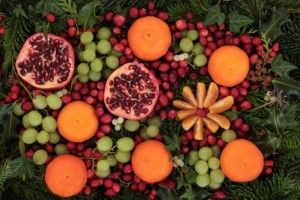Ring in the New Year with a side of good fortune! Around the world, certain foods are eaten on New Year’s Eve or Day because they promise to deliver luck, wealth, and blessings in the coming year. Whether it’s coins, progress, or simply health and happiness, these tasty traditions are rich with symbolism for the future. So, as the ball prepares to drop, gather ingredients that reflect your hopes for the New Year. Read on to discover the magic behind these lucky eats!
Ring in the New Year With These Lucky New Year’s Foods
New Year’s Eve is almost here, and people everywhere have fun traditions and superstitions about what to eat to bring good luck and prosperity in the coming year. Let’s explore some of the most popular lucky New Year’s foods from around the world!
Why Do People Eat Lucky Foods on New Year’s?
Eating specific “lucky” foods on New Year’s Eve or New Year’s Day is thought to influence what the new year will bring. Many of these foods represent hopes for the future through their shape, color, or other attributes. For example, round or coin-shaped foods symbolize wealth, greens represent money, and pork signifies progress.
12 Lucky Grapes
Eating 12 grapes at midnight on New Year’s Eve is a tradition in Spain and many Spanish-speaking countries. The 12 grapes represent the 12 months of the year. Some people make a wish while eating each grape for the months ahead! Many cultures eat twelve grapes on New Year’s Eve: each represents the chime of a clock/or one for each month of the year…some people even make a wish for each grape.
Round fruits
Round fruit brings good fortune since they are round like coins, and their sweetness is thought to bring good things in the New Year. Check out New Years Lucky Foods Shopping List for a complete list of fruits.
Beans for Coins
Legumes like beans and lentils are thought to represent coins. Eating black-eyed peas on New Year’s Day has long been good luck in the American South. Black Eyed Peas & Lentil Recipes. In Italy, lentils signify prosperity for the new year. Their round shape and abundance help explain the coin connection. All types of beans are said to bring good luck. In the South, eating black-eyed peas on New Year’s is said to bring good fortune. In many European countries, green lentils are famous as they are green, representing the color of money.
Greens for Money
Because of their color, cooked greens like collard greens, kale, cabbage, and Swiss chard are said to attract wealth in the new year. Some believe eating more greens equals more greenbacks! Spinach is another healthy green option with supposed lucky properties. Some believe the more greens you eat on the 1st, the more money you will have in the coming year.
Pork for Progress
On New Year’s Day, pork is a better protein pick than chicken or beef because pigs root forward when foraging for food. This signifies moving forward into the new year (we all want to move forward, not backward in the New Year!). Consider serving ham, pork chops, bacon, or hoppin’ John, the traditional Southern dish of black-eyed peas and rice with pork. If you are the cook in the house, consider putting pork, ham, or bacon in your black-eyed peas or lentils for added flavor. Great recipe: Cuban Tamales Recipes with pork. Fish is also a good choice, but not lobster, as, again, they move backward.
Fish for Strides
Fish can be another symbolic New Year’s protein because they generally swim forward. Just steer clear of shellfish like lobster and crab, which move backward and could represent setbacks. Having fish on New Year’s Eve is an Italian and Polish tradition for good luck.
Long Noodles for Long Life
In Chinese culture, long noodles represent longevity for the coming year. Popular lucky New Year’s noodle dishes include lo mein in Chinese cuisine and soba noodles in Japan. Slurping up the extra-long noodles is part of the tradition!
Cornbread and Molasses
Enjoying cornbread and molasses on New Year’s Day originates from the American colonial era. The golden color of cornbread gives a nod to prosperity, as does the sweetness and richness of molasses. The two foods together still make a beloved and supposedly lucky combination!
Pomegranates for Fertility and Life
As a symbol of life and fertility with their plentiful seeds, pomegranates are a New Year’s tradition in Turkey and parts of Europe. Their bright red color also connects to health and vitality for the future. The round shape is a bonus representing fortune and wholeness.
As the clock strikes midnight and toasts are made to the coming days, know that the menu also matters! Pork, beans, greens, fish, grapes, and more—each food outlined here overflows with myth and meaning to kick off your ne
Did we miss any New Years lucky foods?












In the South it was good luck for the year, and you had to have it on New Year’s day, Turnip Greens (which represented money) Fried Hog Jowl (like thick bacon which represented good judgement) blackeyed Peas (represented good change) and it didn’t hurt to have a hot thick wedge of freshly made cornbread with real butter melted on it. And Boy, I eat a lot of each.
[…] So, in our family, we get as much ready as possible before midnight on New Year’s Eve. Lucky Foods for New Years Day. Make sure you are prepared ahead of time. New Year Lucky Things to Do – New Year’s Eve […]